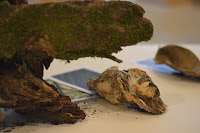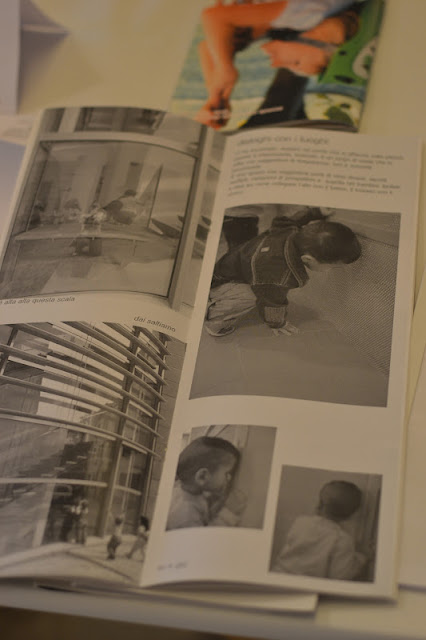Thursday
19th of APRIL
International
Centre Loris Malaguzzi –Auditorium
“Traces of
Children's Graphics in Town”
Maddalena Tedeschi
Video Hall in the Marco Gerra Exhibition Hall.
It's important crucial, vital
that children have these connections with their community.
When given the opportunity,
these connections take the form primarily of graphics. They go beyond the obsticals
of what is perceived struggles with presentations or relationships with members
of the community to create a new culture, new cultural work. These are evident
in the exhibit Traces of Children’s Graphics in Town, where we wanted to make an event a very public
event, drawing attention to ourselves and what we do in the community.
Schools were asked to chose one shop or place in town and make graphics of it
for display for the community, in children’s language of
graphics/signs/messages/drawings. Using this Italian language:
Graphic – using a tool
Senyo – making a line
De Senyo – receiving a line
We set up a date present
throughout the town on the 12th of November for the town to come
alive with children’s work. Each school chose a place in the old town, places
chosen were, restaurants, food markets, bookstores, libraries, bottle shops. The
schools were to work under the conditions – SHORT TIME TO WORK – GRAPHICS WITH NO
COLOUR
This was to offer people
opportunities to see the work we do in our approach.
We wanted images to be poor
simple graphics – we wanted to build a relationship with the work we do
everyday in the community.
It was not to display the work we do in the centres but pieces of everyday
work. The language of signs and drawing language we all posses.
Loris
Malaguzzi, “(Graphics is) a neutral language which belongs to all children” It is important to be extremely
cautious in all the interpretations we do here, interpretations can not be unilateral”
Documents of learning, Matters that Leave Traces types of marks - teachers exploration
Gulliver school
Isabella Meninno
Children draw with pleasure we need to provide environments and spaces for children to do this everyday!!
Children draw with pleasure we need to provide environments and spaces for children to do this everyday!!
Sometimes children specialise
and build up models, concepts or ideas – these draw form over time.
We
are interested in the context we offer children. We wan to be able to better analysis
our adult work in the contexts we offer the children. If we offer different
materials what might happen, we ask ourselves, this was the driving force of
our project, in display in Reggio Children.
What
happens on plastic, felt, corregated board, cardboard, tin. What might happen
in the image of the work and when children are doing it. A kind of magic.
Do
adults know the materials they offer do they explore them, themselves first, a
kind of deconstructing their thinking. HOW TO PROPOSE THESE IDEAS WITH CHILDREN!
UNCOMPOSED
CHAIRS
Robinson school
Atelierista Loretta Bertani
Our objective was to decompose
the chair – a great provocation
We looked at the language of mark making. We
looked at children feeling well, staying well, our first project was the table.
I nthe beginning we used special magnifying lens looking at food. At the
mathematics of setting the table, looking at settings in many different ways.
When asked to chose a place in
the town we looked at a restaurant, we were very concernened with the well
being of the table , taking acare at the table in context of where we were ‘in
a resturant’ and at the context of taking care in general. The children visited
the restaurant and considered this and with permission took a chair from the
restaurant to work with in the classroom.
They asked themselves what is it
that makes you feel ‘ well being’ at home at the table one child said ‘ I feel
well at the table’.
They looked through the conversations had
wit hthe children and considered the ‘boredom of waiting’ and how children deal
with this in a restaurant nad at home.
Children experiemented with the
many different tools used at the table and focused on the material napkin and
looked at the the many formations they could make with napkins.
They used the language olding,
smoothing, opening, tearing rolling into a ball, opening with oyur hand.
There was an empathy between the
material and the children and the material.
The children used a cut out of
the chair photographed to re-draw
it as an animal and crocodile as a graphic to assist their imagination. A
relationship between a chair and a body is researching they learnt.
They look to destabilise the
child body to become transformed. 4 different perspectives from children were
shown, their quotes were shown also.
The teachers choices are of
great importance in the way the project unfolds, they came to decisions based
on students work in 2-3, small groups and medium sized groups of 8-10. The
children worked out, being watched by others was very important this helped
them focus their ideas. They asked themselves what is the adults’ role of
intervention.
Kids lend and loan ideas from
each other giving advise. These expressions exchanges are legitemized by the
adults’ work and observations. Students
work journeys are individualised by the 27th of Oct ready for
presentation Nov 21st, all changes are annotated. It is really
important for students to look at their drawings, their work over time.
Giving the children that time to look over their work this happens a couple of
days a week, this is very very important.
To Recognise and Reknow
They asked the children in
relation to the project ‘Is it easier to draw a child in a composed or
uncomposed way on a chair”. New journeys will they be porportions or
disporportions.
Points of View
International Centre
State School
Francesca Manfredi
Documentation is shared by
people over competencies, experiences and points of view.
It attributes to experiences
that have been lived it is not a narrative – it is a point of view.
REALITY IS A DIMENTIONAL
SUBJECTIVITY
Subjective nature of seeing it
over time.
Drawing is not only a gesture
but a thought. Drawing activates listening to ourselves in a more active way.
The drawing traces, the idea and emotions which the reality has generated
within us. Not drawing which is illustrative but drawing that describes the
idea of things. “How we represent the dialogue of things”. The world is made up
of many things material if we as a team create a dialogue with things (ie:
trees in the woods) we create a greater capacity to see them – to look with
concentration > this is the stopping slowing down of time.
Drawing is provisional. We must
keep Alive this sense of complexity that is part of reality. Do not flatten or
break down this complexity.
This may be reflected in
TRANSPARENCY IN ROOMS
DIFFERING LEVELS
EXPLROING TRANSFORMATION THROUGH
MATERIALS
STUDENTS HAVING OPPORTUNITIES
EXPERIEMENT WITH CONCEPTS AND
TIME
Caring and observing gardens
also represent this, this is very important.
TIME WITH MATERIALS IS A VERY
LONG TIME.
Transformation is intr\egral to
our ways of seeing and looking it is represented through materials to explore
materials.
WE MUST GIVE OURSELVES TIMES AND
PSACES TO WORK DIRECTLY WITH THE CHILDREN AND MATERIALS. WE AS ADULTS EXPLORE
PLACES FIRST TO CREATE MAPS AND POINTS OF VIEW TO HELP US ORIENTATE THE WAYS
THE STUDENTMIGHT EXPLORE THE SAME AREA. Kids look at multiple geographies of
the same world.
Schools’ whole RE community
Project – old city
Super marcato Xian Hua
Kids chose materials from the
supermarket and bought them back to school. They made compositions with these
objects. They noted different variable in light, composition, creating order
and relationshios between things. There are rhythms and justapositions, linear
and non-linear.
KIDS MAKING DECISIONS
Their representations appear
mathematical.
POINTS OF VIEW
means realities that are multi-dimensional
TEMPO – Time
SOGGETTIVITTA – Subjective
What materials do we choose?
What types of things do we want
to present?
What ideas do we want to
explore?
What is the relationship between
the contexts we have?
A HABITAT OF EXPERIENCES OF
THINKING OF IDEAS
An ecosystem of the environment
and context.
Children – How do they think,
connect to adults thinking, connection to other children’s thinking???
Children need to reencounter the
same contexts they need to find out if it is a stable realisation.
Teachers it is
fundamental the point in which we create contexts.
We cannot consider
an experience as a stable encounter if they have only experienced it once.
Reminded that each
encounter changes as no two experiences are the same!
We are
opening many different entries ways into learning> providing each child his
or her own way of learning.
MULTIPLE ACCESS POINT TO LEARNING
We need to have
joy, fun learning dialogue or the well planned thought out experience will
die!!!
It is the process in which the
adults assess themselves they have to through the children’s ideas see if they
offer them the best possible conditions for learning to take place.























No comments:
Post a Comment